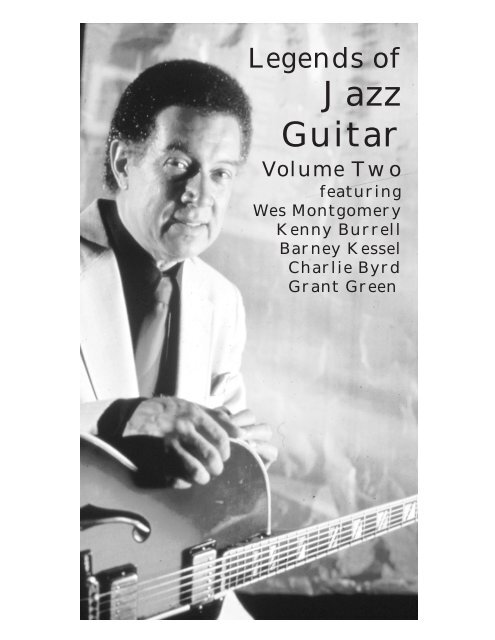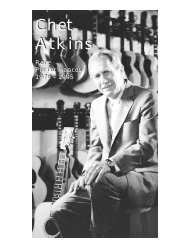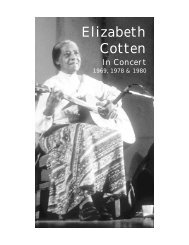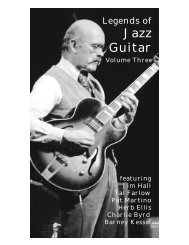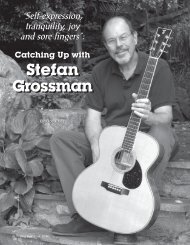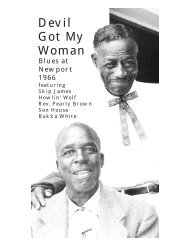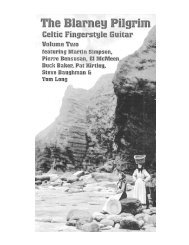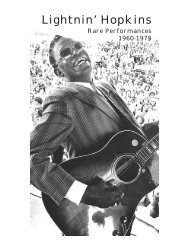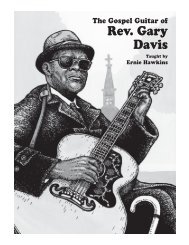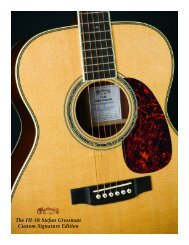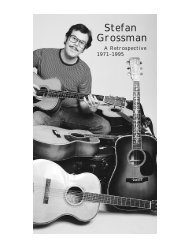Legends of Jazz Guitar - Stefan Grossman's Guitar Workshop
Legends of Jazz Guitar - Stefan Grossman's Guitar Workshop
Legends of Jazz Guitar - Stefan Grossman's Guitar Workshop
Create successful ePaper yourself
Turn your PDF publications into a flip-book with our unique Google optimized e-Paper software.
<strong>Legends</strong> <strong>of</strong><br />
<strong>Jazz</strong><br />
<strong>Guitar</strong><br />
Volume Two<br />
featuring<br />
Wes Montgomery<br />
Kenny Burrell<br />
Barney Kessel<br />
Charlie Byrd<br />
Grant Green
LEGENDS OF JAZZ GUITAR<br />
VOLUME TWO<br />
by Mark Humphrey<br />
What becomes a legend most?<br />
Judging from the dazzling<br />
improvisatory exchanges in the<br />
trio performance which opens this<br />
video, perhaps it’s comradely<br />
competition. Then again, it may<br />
be the challenge a master improviser<br />
like Joe Pass makes <strong>of</strong> the blues idiom.<br />
Rhythms that are anything but routine<br />
please these legends, as do the<br />
harmonic textures they extract from<br />
standards. Drive delights these legends,<br />
but so, too, does understatement.<br />
Variety apparently becomes these<br />
legends best. They deliver dynamics,<br />
sundry shades <strong>of</strong> blue and brighter<br />
tonal colors as well. Chameleon-like,<br />
they change sonic shades without<br />
notice. They run the gamut<br />
from playfully funky to<br />
moody and meditative,<br />
and it is their absolute<br />
mastery <strong>of</strong> so much<br />
emotional and musical<br />
territory which justifies<br />
calling these<br />
artists legends.<br />
2
BARNEY KESSEL<br />
“Above all, the humanness <strong>of</strong> a performer should<br />
be apparent...the essence <strong>of</strong> a living being is greater<br />
than the music. The music is only an expression<br />
<strong>of</strong> that essence.” — Barney Kessel<br />
Photo by Tom Copi<br />
Articulate and passionate, Barney Kessel has been<br />
a crusader for jazz since discovering it in his teens in<br />
Muskogee, Oklahoma. That was Kessel’s birthplace in<br />
1923, and it was there he first explored jazz in an otherwise-black<br />
band at age 14. “I knew what I wanted to find,”<br />
Kessel once remarked <strong>of</strong> his first forays into jazz, “and I<br />
used the guitar to find it.”<br />
Finding Charlie Christian grooving to his playing at<br />
an Oklahoma City club was the shock <strong>of</strong> Kessel’s life.<br />
Christian’s encouraging words (“I’m gonna tell Benny<br />
about you”) inspired the sixteen-year-old Kessel to strike<br />
out on his own, first to the upper Midwest and ultimately<br />
to California. There his presence at jam sessions brought<br />
him to the attention <strong>of</strong> producer-promoter Norman Granz,<br />
who enlisted Kessel (along with Lester Young and other<br />
greats) for the 1944 film short, Jammin’ the Blues. Kessel<br />
soon took the guitar chair in a succession <strong>of</strong> notable big<br />
bands, including those <strong>of</strong> Artie Shaw, Charlie Barnet, and<br />
Benny Goodman. He began exploring bebop when Dizzy<br />
3
Photo Courtesy <strong>of</strong> Ashley Mark Publishing Co.<br />
Gillespie and Charlie Parker came to Los Angeles in 1945.<br />
He played with Parker on a 1946 Dial Records session<br />
and became a mainstay <strong>of</strong> the Hollywood studios, backing<br />
everyone from Bird to Billie Holiday.<br />
In 1952, Kessel joined Oscar Peterson’s trio. His tenmonth<br />
stint with the group brought him greater attention<br />
and gave him the confidence to begin recording and performing<br />
as leader. Despite a busy schedule <strong>of</strong> session<br />
work, Kessel became the leading voice <strong>of</strong> jazz guitar in<br />
the 1950s. He routinely walked away with the guitar honors<br />
in down beat’s annual poll until Wes Montgomery<br />
unseated him in 1963.<br />
Kessel continued to be an active and influential force<br />
in jazz guitar throughout the 1960s-1980s. His composition,<br />
“Blue Mist,” is the springboard for stunning ‘conversations’<br />
among Kessel, Kenny Burrell, and Grant<br />
Green captured at Ronnie Scott’s in London in 1969. An<br />
example <strong>of</strong> jazz artistry at its peak, the exchange <strong>of</strong> solos<br />
culminates with each guitarist making statements<br />
brilliantly extended by the others.<br />
1974’s “BBC Blues” is a Kessel revision <strong>of</strong> “Basie’s<br />
Blues” (see <strong>Legends</strong> <strong>of</strong> <strong>Jazz</strong> <strong>Guitar</strong>, Volume One) with a<br />
title honoring the company which taped it. It’s an example<br />
<strong>of</strong> Kessel in top form exhibiting what Norman<br />
Mongan, in The History <strong>of</strong> the <strong>Guitar</strong> in <strong>Jazz</strong>, calls “His<br />
4
personal mannerisms — the upward (or backward) rake<br />
across the strings, the extroverted use <strong>of</strong> blue notes,<br />
smears, chordal solos — (which) make his approach immediately<br />
recognizable.” And Kessel’s signature sound<br />
has become an indelible part <strong>of</strong> jazz guitar history. “You<br />
look at the guitar as a tool,” he told Arnie Berle, “to help<br />
you manifest what it is you already hear — to bring out<br />
what you have inside.”<br />
Photo Courtesy <strong>of</strong> Tropix International<br />
KENNY BURRELL<br />
“I can spot his playing anywhere. His chord<br />
conception is wonderful, and you’re always aware<br />
<strong>of</strong> the harmonic movement in his work.<br />
That’s particularly evident in his single-string<br />
solos. He’s just one <strong>of</strong> the greats.”<br />
— Tal Farlow on Kenny Burrell<br />
“I wanted to<br />
play saxophone,”<br />
Kenny Burrell once<br />
said, “but we could<br />
not afford a sax.”<br />
Born in Detroit in<br />
1931, Burrell grew<br />
up in a musical family<br />
(his older brother<br />
Billy played guitar,<br />
as did his father).<br />
Burrell’s early heroes<br />
were the great<br />
sax men Coleman<br />
Hawkins and Lester<br />
Young, but he discovered<br />
a guitarist<br />
<strong>of</strong> comparable genius<br />
when he heard<br />
Charlie Christian.<br />
“He wanted to get a<br />
certain sound,” said Burrell, “and he felt this so deeply<br />
that he was able to overcome the limits <strong>of</strong> the instrument<br />
to obtain it.” Burrell got a $10 steel-string and be-<br />
5
gan his own struggle with its limits: “If your feeling is<br />
strong enough,” he observes, “you can get your sound.”<br />
Burrell’s sound was first heard in pianist Tommy<br />
Flanagan’s trio in 1947. At age 19, Burrell was hired by<br />
Dizzy Gillespie for a month and recorded for Gillespie’s<br />
Dee Gee label. Despite many <strong>of</strong>fers to tour, Burrell pursued<br />
a Bachelor <strong>of</strong> Music degree in theory and composition<br />
at Wayne State University. He studied classical guitar<br />
in college, then spent six months subbing for an ailing<br />
Herb Ellis in Oscar Peterson’s trio. In 1956, he moved<br />
to New York, where his reading ability helped him establish<br />
himself in the studios. “There weren’t many guitarists<br />
who could play blues as well as read,” Burrell noted.<br />
His first Blue Note album, Introducing Kenny Burrell (LT-<br />
81523), was recorded in July 1956, and led to years <strong>of</strong><br />
New York-based sessions for Blue Note and Prestige along<br />
with studio work accompanying everyone from James<br />
Brown to Lena Horne.<br />
“If you’re lucky,” says Burrell, “you should be able<br />
to make a living at something you enjoy doing.” Burrell,<br />
whose career has included teaching at UCLA as well as<br />
touring and recording, is extremely lucky. We first encounter<br />
him exchanging volleys with Barney Kessel and<br />
Grant Green in the spectacular “Blue Mist.” Next he appears<br />
at 1987’s San Remo <strong>Jazz</strong> Festival in the company<br />
<strong>of</strong> bassist Dave Jackson and drummer Kenny Washington.<br />
“Lover Man” is an exquisite interpretation <strong>of</strong> this standard<br />
which showcases the qualities (“wonderful chord<br />
conception and harmonic movement”) Tal Farlow admires<br />
in Burrell. The Kurt Weill-Ira Gershwin composition,<br />
“My Ship,” sails on an acoustic steel-string and demonstrates<br />
another side <strong>of</strong> this versatile guitar master.<br />
“When someone turns on the radio and hears four bars<br />
and recognizes that it’s your sound,” says Burrell, “that<br />
is the thing that makes the difference, along with being<br />
really musical and consistent.”<br />
6
Photo by Tom Copi<br />
7
GRANT GREEN<br />
“Green consolidated the place <strong>of</strong> the guitar in the<br />
‘soul-jazz’ movement <strong>of</strong> the early 1960s.”<br />
— Norman Mongan, The History <strong>of</strong> the <strong>Guitar</strong> in <strong>Jazz</strong><br />
St. Louis-born<br />
Grant Green (1931-<br />
1975) was introduced<br />
to the guitar by an<br />
uncle he recalled playing<br />
“old Muddy Waters-type<br />
blues.” His<br />
first instrument was a<br />
Harmony with an amplifier,<br />
Green recalled,<br />
that “looked like an<br />
old-timey radio.” After<br />
a stint with a St. Louis<br />
gospel group, he<br />
served an apprenticeship<br />
playing standards<br />
with accordionist Joe<br />
Murphy, who Green remembered<br />
as “a rarity<br />
and novelty. You just<br />
didn’t find any black people playing accordion then.”<br />
Green’s emergence in the 1960s was hailed by some<br />
critics as a renaissance <strong>of</strong> Charlie Christian’s style: “Green<br />
is particularly concerned with the guitar’s horn-like possibilities,”<br />
wrote Robert Levin, “and has reduced certain<br />
elements <strong>of</strong> Charlie Christian’s approach to their basics.”<br />
Without denying an affinity, Green said he was less consciously<br />
influenced by Christian than he was alto sax giant<br />
Charlie Parker. “Listening to Charlie,” he told Gary<br />
N. Bourland, “was like hearing a different man play every<br />
night.” Listening to Charlie brought Green to jazz.<br />
In 1960, Green moved from St. Louis to New York<br />
after tenor saxophonist Lou Donaldson recommended<br />
Green to Blue Note Records. Green’s debut album,<br />
Grant’s First Stand (Blue Note BLP 4086), met with rave<br />
reviews and initiated a decade which found Green busy<br />
Photo by Tom Copi<br />
8
as session man on Blue Note recordings fronted by Lee<br />
Morgan, Stanley Turrentine, and Jimmy Smith, among<br />
others. Green won down beat’s New Star Award in 1962,<br />
and as part <strong>of</strong> the 1969 triumvirate <strong>of</strong> Kessel, Burrell,<br />
and Green, burned through Kessel’s “Blue Mist” with soulful<br />
fervor.<br />
WES MONTGOMERY<br />
“It doesn’t matter how much artistry one has;<br />
it’s how it’s presented that counts.” — Wes Montgomery<br />
Photo by Chuck Stewart<br />
By any measure <strong>of</strong> artistry and the presentation<br />
there<strong>of</strong>, Wes Montgomery was a giant. Born John Leslie<br />
Montgomery on March 6, 1925, in Indianapolis, Indiana,<br />
Wes was a late bloomer. He took up the guitar at 19, first<br />
a tenor and then a six-string electric. His interest was<br />
fired by the recordings <strong>of</strong> Charlie Christian: “I don’t care<br />
what instrument a cat played,” Montgomery said, “if he<br />
9
didn’t understand and feel the things that Charlie Christian<br />
was doing, he was a pretty poor musician.”<br />
Employed as a welder, Montgomery diligently sat with<br />
his guitar and Charlie Christian records for hours. “The<br />
biggest problem,” he said <strong>of</strong> the guitar, “is getting<br />
started... It’s a very hard instrument to accept, because<br />
it takes years to start working with...” Montgomery was<br />
working well enough with it by 1948 to land a job with<br />
Lionel Hampton, a stint which let him polish techniques<br />
achieved partly by accident: a neighbor’s complaint<br />
prompted Montgomery to drop the pick and try “plucking<br />
the strings with the fat part <strong>of</strong> my thumb. This was<br />
much quieter,” he recalled. The unique attack he developed<br />
with his thumb, along with what Montgomery called<br />
“the trick <strong>of</strong> playing the melody line in two different registers<br />
at the same time — the octave thing,” became his<br />
trademarks. <strong>Guitar</strong>ist Les Spann, who marveled at<br />
Montgomery’s “perfect knowledge <strong>of</strong> the instrument,”<br />
noted that Montgomery’s thumb “gives his playing a very<br />
percussive feeling and remarkable tone.”<br />
As seen in this video, Montgomery was as graceful<br />
and assured as he was dynamic. The apparent effortlessness<br />
<strong>of</strong> his playing was actually the result <strong>of</strong> years <strong>of</strong><br />
hard work: “I used to have headaches every time I played<br />
those octaves,” Montgomery told Ralph Gleason, “because<br />
it was a strain, but the minute I’d quit, I’d be all<br />
right. I don’t why, but it was my way, and my way just<br />
backfired on me. But now I don’t have headaches when I<br />
play octaves. I’m showing you how a strain can capture<br />
a cat and almost choke him, but after awhile it starts to<br />
ease up because you get used to it.”<br />
Montgomery spent most <strong>of</strong> the 1950s giging locally<br />
in Indianapolis while keeping his day job at a radio parts<br />
factory to support his large family. His break came in<br />
1959, when Cannonball Adderly recommended him to<br />
Riverside Records. His recordings were hailed as revelations,<br />
and Montgomery quickly gained a star status unprecedented<br />
in the history <strong>of</strong> jazz guitar. The jazz critics<br />
and aficionados who heralded Montgomery in the early<br />
1960s were dismayed when, shortly after the performances<br />
in this video were made, he began playing jazz<br />
10
versions <strong>of</strong> pop tunes (“Going Out <strong>of</strong> My Head” won Montgomery<br />
a 1966 Grammy). It could be argued that<br />
Montgomery’s jazz-pop hybrid brought jazz guitar a wider<br />
listenership, but the consensus on his music was bitterly<br />
divided at the time a heart attack claimed this giant in<br />
1968.<br />
The accusations <strong>of</strong> ‘selling out’ had yet to be hurled<br />
at Montgomery when he delivered the brilliant performances<br />
captured on this video. Accompanied by pianist<br />
Harold Mabern, bassist Arthur Harper and drummer<br />
Jimmy Lovelace, Montgomery made a 1965 appearance<br />
on the BBC’s <strong>Jazz</strong> 625 program. The sheer joy <strong>of</strong> creating<br />
such joyous music is seen in Montgomery’s face while<br />
playing the saucy “Full House,” an original composition.<br />
Contrasting to its “Take Five”-ish <strong>of</strong>f-kilter rhythms is<br />
the bluesy brilliance <strong>of</strong> Thelonious Monk’s “‘Round Midnight.”<br />
Montgomery’s Riverside recording <strong>of</strong> this on an<br />
album by the same name is regarded as one <strong>of</strong> the greatest<br />
interpretations <strong>of</strong> this standard. Here Montgomery<br />
balances power with understatement superbly supported<br />
by his ensemble’s subtle playing (note the brief shift to a<br />
Bolero rhythm towards the end). A genius who understood<br />
the art <strong>of</strong> sharing the spotlight, Montgomery once<br />
told fellow guitarist Jimmy Stewart: “In jazz music in recent<br />
years, most sidemen want to be the leader and most<br />
leaders want to be the whole show. Very few people reach<br />
the top in their field, and you should not be frustrated by<br />
not reaching the top. The process <strong>of</strong> achieving your goal<br />
is more rewarding than the goal itself.”<br />
11
12<br />
Photo by Tom Copi
CHARLIE BYRD<br />
“Some guitarists impress me.<br />
Some guitarists reach me. Charlie Byrd does both.”<br />
— Herb Ellis on Charlie Byrd<br />
Charlie Byrd’s background is nothing if not eclectic.<br />
Born in Chuckatuck, Virginia, in 1925, Byrd’s first musical<br />
experiences were playing country music on the radio<br />
in Newport News with his father. He later tried his hand<br />
at playing jazz with a pick, only to be seduced by the<br />
sounds <strong>of</strong> the classical guitar. He studied with Segovia in<br />
1954, but experienced a withering revelation: “I really<br />
wasn’t going to be a significant classical guitar player,”<br />
Byrd recalls. Subsequently he decided to arrange some<br />
jazz for classical guitar, and this new sound debuted on a<br />
1956 Savoy label album, <strong>Jazz</strong> Recital.<br />
Byrd’s new approach to jazz found a welcome audience.<br />
He won down beat’s New Star award in 1960, the<br />
same year he toured with Woody Herman’s band. The<br />
following year the State Department sponsored Byrd’s<br />
musical goodwill tour <strong>of</strong> Latin America, an event which<br />
led to Byrd’s role in introducing Brazil’s ‘new beat’ (bossa<br />
nova) sound to America. His duet album with Stan Getz,<br />
13
<strong>Jazz</strong> Samba (Verve<br />
6-8432), was the<br />
breakthrough for<br />
Brazilian music in<br />
America. “I guess<br />
that got me typecast<br />
a little more<br />
than I would have<br />
liked,” Byrd said <strong>of</strong><br />
the bossa nova<br />
craze, “but I like<br />
making arrangements<br />
<strong>of</strong> pretty<br />
tunes and having a<br />
go at improvising<br />
on them.”<br />
He does that<br />
superbly with Fats<br />
Waller’s “Jitterbug<br />
Waltz” in a trio with<br />
his brother, Joe<br />
Byrd, on bass and Wayne Phillips on drums in a 1979<br />
performance for Iowa Public Television (<strong>Jazz</strong> at the Maintenance<br />
Shop). Byrd also takes an eloquent solo turn on<br />
Irving Berlin’s “Isn’t It a Lovely Day,” demonstrating that<br />
classical music’s loss has proven to be jazz’s gain. “I realized,”<br />
Byrd said after his studies with Segovia, “that it<br />
might be a better idea for me to use all my life’s experience,<br />
in jazz and popular music as well, combining them<br />
with classical... There are so many different ways to view<br />
music, and all <strong>of</strong> them can be fruitful. I think the fun is to<br />
pursue your own.”<br />
Photo by Tom Copi<br />
14
Photo by Michael P. Smith<br />
JOE PASS<br />
“...the guitar player has a beautiful tone,<br />
he phrases good, and...it’s really together.”<br />
— Wes Montgomery responding to a ‘blindfold test’<br />
playing <strong>of</strong> Joe Pass’s “Sometime Ago”<br />
Gene Autry was his initial<br />
inspiration to play<br />
guitar. Later, he would<br />
discover the recordings<br />
<strong>of</strong> a fellow Italian-American,<br />
Eddie Lang (born<br />
Salvatore Massaro),<br />
whose version <strong>of</strong> “My<br />
Blue Heaven” especially<br />
impressed him: “He<br />
played a whole chorus in<br />
chords and single notes,”<br />
Joe Pass recalled, “and it<br />
was as modern as<br />
anybody’s playing now.”<br />
It was Pass who brought<br />
the art <strong>of</strong> solo jazz guitar<br />
(“chords and single<br />
notes”) to heights Lang<br />
could scarcely imagine,<br />
as witnessed by his two performances in this video. “What<br />
you have to do,” he reflected, “is develop your own character<br />
in music, your own way <strong>of</strong> doing things.”<br />
Joseph Anthony Passalaqua got a $17 Harmony guitar<br />
for his ninth birthday in 1938. “It had a big, thick<br />
neck,” he recalled, “and was really hard to play.” But<br />
play it he did, sometimes up to six hours a day under the<br />
watchful eye <strong>of</strong> a father who wanted something better<br />
for his son than a steelworker’s life in Johnstown, Pennsylvania.<br />
Pass was playing VFW dances with a local band<br />
at age 12, and before his teens ended he had chalked up<br />
road tours with the big bands <strong>of</strong> Tony Pastor and Charlie<br />
Barnet. By the late 1940s Pass was in New York, jamming<br />
with some <strong>of</strong> the pioneers <strong>of</strong> bebop: “The harmonic<br />
concept, the long melodic lines <strong>of</strong> the solos impressed<br />
15
me,” he recalled, “and I listened to the saxes and trumpets,<br />
trying to play like them.”<br />
Unfortunately, he joined the many jazz artists <strong>of</strong> the<br />
era who fell prey to heroin addiction. From 1949 to 1960,<br />
“I played all over the States in those identical cocktail<br />
lounges with the red leather seating,” Pass recalled, “usually<br />
for a week or two at most... All that time I wasted, I<br />
was a bum, doing nothin’. I could have made it much<br />
sooner but for drugs.” Pass straightened out in 1961, and<br />
his career took <strong>of</strong>f.<br />
His first album as leader, Catch Me (Pacific <strong>Jazz</strong> PJ<br />
73), debuted to raves in 1963. Two years later, Pass joined<br />
the George Shearing Quintet. Pass teamed with pianist<br />
Oscar Peterson in 1969, and his 1973 duet album with<br />
Herb Ellis, <strong>Jazz</strong> Concord (Concord <strong>Jazz</strong> CJ-1), brought<br />
him a still-higher pr<strong>of</strong>ile. Pass unveiled his extraordinary<br />
solo style on 1974’s Virtuoso (Pablo 2310 707), the album<br />
which effectively made a guitar hero <strong>of</strong> Joe Pass.<br />
Watching him play “Original Blues in A” from a mid-<br />
1970s BBC broadcast, it’s easy to see why. Pass drops a<br />
blues cliché long enough to remind us where we are, then<br />
plays dazzling circles around it. The Ellingtonian chestnut,<br />
“Prelude to a Kiss,” provides Pass a springboard for<br />
breathtaking cascades <strong>of</strong> notes and richly textured harmonic<br />
inventions. While he could play punchy and fast<br />
with a pick, Pass preferred to use his fingers for solos<br />
such as these. “Playing with your fingers is much better<br />
for solo guitar,” he declared. “You can get counterpoint,<br />
add bass lines.” In an interview with Tim Schneckloth<br />
(down beat, March 1984), Pass elaborated on this approach:<br />
“The bass lines, for instance, aren’t always happening.<br />
They’re implied sometimes... But by having<br />
motion — keeping the whole thing moving with substitute<br />
chords, a strong pulse, and so on — it sounds like<br />
it’s all happening at the same time.”<br />
16
17<br />
Photo by Tom Copi
1. KESSEL/BURRELL/GREEN<br />
Blue Mist<br />
2. WES MONTGOMERY<br />
Full House<br />
3. JOE PASS<br />
Blues<br />
4. KENNY BURRELL<br />
Lover Man<br />
5. BARNEY KESSEL<br />
BBC Blues<br />
6. CHARLIE BYRD<br />
Jitterbug Waltz<br />
7. WES MONTGOMERY<br />
'Round Midnight<br />
8. JOE PASS<br />
Prelude To A Kiss<br />
9. KENNY BURRELL<br />
My Ship<br />
10. CHARLIE BYRD<br />
Isn't It A Lovely Day<br />
Running Time: 60 minutes • B/W and Color<br />
Front Cover Photo: Kenny Burrell courtesy <strong>of</strong> Tropix Int.<br />
Back Photos: Wes Montgomery by Chuck Stewart<br />
Barney Kessel by Tom Copi<br />
Nationally distributed by Rounder Records,<br />
One Camp Street, Cambridge, MA 02140<br />
Representation to Music Stores by<br />
Mel Bay Publications<br />
® 2001 Vestapol Productions<br />
A division <strong>of</strong><br />
<strong>Stefan</strong> <strong>Grossman's</strong> <strong>Guitar</strong> <strong>Workshop</strong> Inc.<br />
Virtuosity tempered by taste<br />
and informed by imagination<br />
– it's a constant force in this<br />
collection <strong>of</strong> brilliant jazz<br />
guitar performances. “This is<br />
the magic <strong>of</strong> our kind <strong>of</strong><br />
music,” Barney Kessel has<br />
said <strong>of</strong> jazz improvisation,<br />
and that magic abounds in<br />
these performances. “The<br />
thing is to make music,”<br />
Kenny Burrell once observed,<br />
“no matter what the tempo.<br />
That, to me, is the most<br />
demanding part <strong>of</strong> anything.<br />
It's not the physical or the<br />
technical part. It's just the<br />
idea <strong>of</strong> making it musical.”<br />
The high-wire act <strong>of</strong> balancing<br />
virtuosity and musicality<br />
meets its match in the<br />
remarkable artists seen in this<br />
second volume <strong>of</strong> <strong>Legends</strong><br />
Of <strong>Jazz</strong> <strong>Guitar</strong>.<br />
Vestapol 13033<br />
ISBN: 1-57940-915-6<br />
0 11671 30339 0


